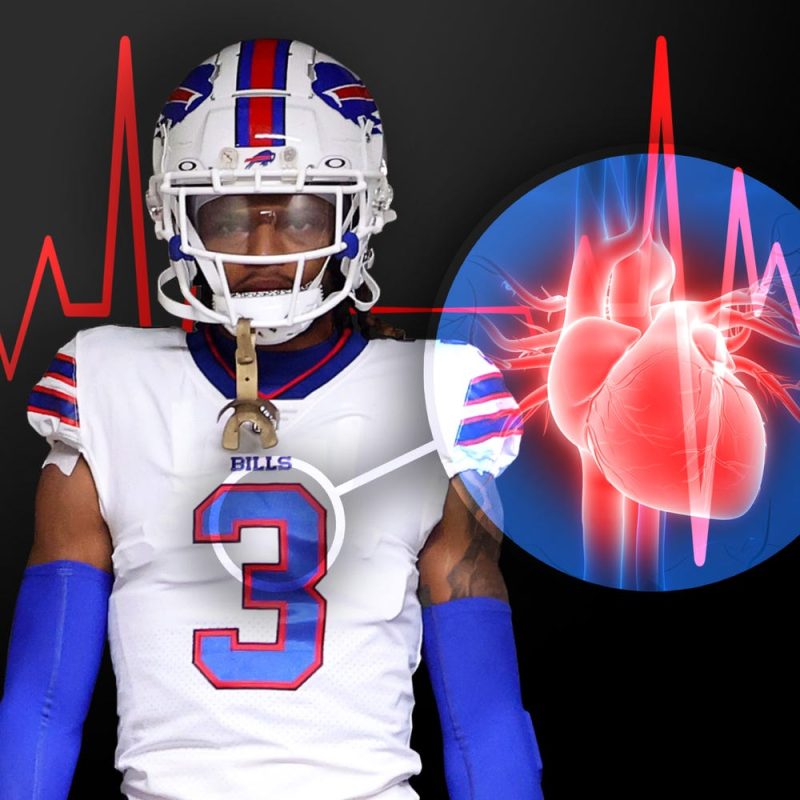In the minutes following Damar Hamlin’s cardiac arrest Monday night, reports say the Buffalo Bills player was given CPR, oxygen and put on a stretcher before an ambulance took him to a hospital.
An automated external defibrillator, or AED, was also used on the field before his heartbeat was restored, the NFL confirmed to USA TODAY on Tuesday.
But as players and medical personnel crowded the football field, it’s hard to know exactly what happened – or what should have happened – after Hamlin collapsed during the game against the Cincinnati Bengals.
While many details remain unclear, health experts say the on-field treatment falls in line with emergency response protocols.
‘Time is important,’ said Dr. Laxmi Mehta, director of preventative cardiology and women’s cardiovascular health at the Ohio State University Wexner Medical Center in Columbus. ‘Speedy treatment is essential in order to preserve heart muscle and brain tissue function and the other organs.’
Damar Hamlin’s collapse and cardiac arrest: What happened
Hamlin tackled Bengals wide receiver Tee Higgins after a 13-yard gain. Hamlin stood up but immediately collapsed to the ground.An ambulance was brought onto the field while he was administered CPR for nearly 10 minutes, according to play-by-play announcer Joe Buck.His heartbeat was restored on the field. Prior to going into the ambulance, he was placed on a stretcher and given oxygenThe Bills said early Tuesday morning the 24-year-old suffered a cardiac arrest and was transferred to the University of Cincinnati Medical Center where he was sedated as of Tuesday afternoon.
But first, what is cardiac arrest?
Sudden cardiac arrest happens when the heart suddenly loses its normal rhythm and stops pumping blood, according to the Sports Institute, part of the University of Washington School of Medicine system.
“With a cardiac arrest, there’s simply no blood flow to any organ in the body and so the person almost immediately loses consciousness, just as you could see happened to Damar on the field,” said Dr. Lance Becker, professor at the Feinstein Institutes for Medical Research and chairman of emergency medicine at Northwell Health. “That’s the classic way that a sudden cardiac arrest would present.”
How to recognize cardiac arrest
Mehta said checking someone’s pulse through their arm or neck can help a bystander determine if someone is undergoing cardiac arrest. If there’s no pulse, the heart isn’t working.
However, Becker said even some of the most experienced medical providers have trouble locating a pulse and instead suggests people use the ‘No-No-Go’ approach:
No consciousness: The person isn’t awake.No breathing: The person isn’t breathing, or isn’t making regular breaths. Go! Start chest compressions.
CPR: Why chest compressions are so important
The main goal of CPR, or cardiopulmonary resuscitation, is not to restart the heart during cardiac arrest, Becker said, and it rarely does.
Chest compressions are meant to imitate the heart’s function of pushing blood to organs of the body.
‘You’re helping the heart by reacting as a pump,’ Mehta said. ‘The chest compressions allow circulation throughout the body, hopefully restoring blood flow to the organs.’
What to know about chest compressions:
Start as early as possible to minimize organ injury Chest compressions can be physically exhausting, Mehta said. Have a few people who know CPR ready to take over when you get tired to make sure compressions are consistently effective. While one person is doing compressions, another person should be retrieving and setting up an automated external defibrillator, or AED, to shock the heart.
AED: What is an automated external defibrillator?
An AED is a portable medical device that analyzes a heart’s rhythm to deliver a shock and restart the heart during a cardiac arrest.
The NFL confirmed an AED was used but it’s unclear how many times it was used and if it restored Hamlin’s heart on the field.
Modern AEDs that are often located in public spaces like gyms or public transportation contain easy instructions to follow. ‘These current AEDs are so amazing that are they easier to use than a microwave,’ Becker said.
To use an AED:
Power on the device. Attach sticky pads on the patients skin as directed in pictures. Wait as the device reads the heart and charges up if a shock is required. Once it’s ready, it will say to push the button to produce a shock.
Mehta said you should stop chest compressions while the device is reading the patients heart and step back from the patient when delivering a shock.
Becker said chest compressions can be resumed after the shock is delivered. In many cases, people continue chest compressions not knowing the heart has already been restored. In other cases, it may take one or two more shocks to restart the heart.
Health and patient safety coverage at USA TODAY is made possible in part by a grant from the Masimo Foundation for Ethics, Innovation and Competition in Healthcare. The Masimo Foundation does not provide editorial input.

